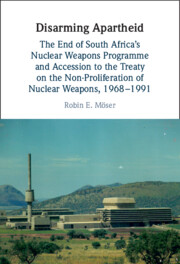 Disarming Apartheid
Disarming Apartheid Book contents
- Disarming Apartheid
- Reviews
- Disarming Apartheid
- Copyright page
- Dedication
- Contents
- Figures
- Acknowledgements
- Abbreviations
- Introduction
- 1 The Development of Pretoria’s Nuclear Industry and Relations with the IAEA, 1950–1977
- 2 Towards Nuclear Weapons – Away from Safeguards
- 3 Nuclear Diplomacy
- 4 Towards the End of South Africa’s Nuclear Weapons and NPT Negotiations, 1988–1989
- 5 South African Movement towards NPT Signature, 1990–1991
- 6 Post-NPT Accession
- Conclusion
- Bibliography
- Index
5 - South African Movement towards NPT Signature, 1990–1991
Published online by Cambridge University Press: 28 March 2024
- Disarming Apartheid
- Reviews
- Disarming Apartheid
- Copyright page
- Dedication
- Contents
- Figures
- Acknowledgements
- Abbreviations
- Introduction
- 1 The Development of Pretoria’s Nuclear Industry and Relations with the IAEA, 1950–1977
- 2 Towards Nuclear Weapons – Away from Safeguards
- 3 Nuclear Diplomacy
- 4 Towards the End of South Africa’s Nuclear Weapons and NPT Negotiations, 1988–1989
- 5 South African Movement towards NPT Signature, 1990–1991
- 6 Post-NPT Accession
- Conclusion
- Bibliography
- Index
Summary
Chapter 5 engages with the brief period of decision-making in which the nuclear rollback decision was initiated by newly elected President F. W. de Klerk. Set against the winding down of the Cold War in the region and the final stages of the Border War in Angola, I discuss the end of the nuclear weapons programme, showing how the South African strategy on NPT accession changed to incorporate the region in an attempt to ultimately broker a NWFZ in southern Africa. I detail how the apartheid regime, and in particular the DFA officials, revised their strategy to enable de Klerk and his advisors to be able to present signature to the Treaty to domestic opponents as a step worthy of pursuance. I also highlight how President F. W. de Klerk’s newly elected government had to consider and balance international opinion and pressure in the form of sanctions and embargoes. Moreover, I illuminate the need for the government to come to terms with a domestic situation of rising unrest and increased right-wing pressure threatening the reforms initiated by the NP, and how Pretoria finally acceded to the NPT.
Keywords
- Type
- Chapter
- Information
- Disarming ApartheidThe End of South Africa's Nuclear Weapons Programme and Accession to the Treaty on the Non-Proliferation of Nuclear Weapons, 1968–1991, pp. 138 - 171Publisher: Cambridge University PressPrint publication year: 2024
